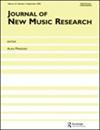Automatic melody harmonization with triad chords: A comparative study
IF 1.1
4区 计算机科学
Q4 COMPUTER SCIENCE, INTERDISCIPLINARY APPLICATIONS
引用次数: 37
Abstract
The task of automatic melody harmonization aims to build a model that generates a chord sequence as the harmonic accompaniment of a given multiple-bar melody sequence. In this paper, we present a comparative study evaluating the performance of canonical approaches to this task, including template matching, hidden Markov model, genetic algorithm and deep learning. The evaluation is conducted on a dataset of 9226 melody/chord pairs, considering 48 different triad chords. We report the result of an objective evaluation using six different metrics and a subjective study with 202 participants, showing that a deep learning method performs the best.三和弦自动旋律协调的比较研究
自动旋律协调的任务旨在建立一个模型,生成一个和弦序列作为给定多小节旋律序列的和声伴奏。在本文中,我们对规范方法的性能进行了比较研究,包括模板匹配、隐马尔可夫模型、遗传算法和深度学习。评估是在9226个旋律/和弦对的数据集上进行的,考虑了48个不同的三和弦。我们报告了使用六种不同指标进行客观评估的结果,以及对202名参与者进行的主观研究,表明深度学习方法表现最好。
本文章由计算机程序翻译,如有差异,请以英文原文为准。
求助全文
约1分钟内获得全文
求助全文
来源期刊

Journal of New Music Research
工程技术-计算机:跨学科应用
CiteScore
3.20
自引率
0.00%
发文量
5
审稿时长
>12 weeks
期刊介绍:
The Journal of New Music Research (JNMR) publishes material which increases our understanding of music and musical processes by systematic, scientific and technological means. Research published in the journal is innovative, empirically grounded and often, but not exclusively, uses quantitative methods. Articles are both musically relevant and scientifically rigorous, giving full technical details. No bounds are placed on the music or musical behaviours at issue: popular music, music of diverse cultures and the canon of western classical music are all within the Journal’s scope. Articles deal with theory, analysis, composition, performance, uses of music, instruments and other music technologies. The Journal was founded in 1972 with the original title Interface to reflect its interdisciplinary nature, drawing on musicology (including music theory), computer science, psychology, acoustics, philosophy, and other disciplines.
 求助内容:
求助内容: 应助结果提醒方式:
应助结果提醒方式:


